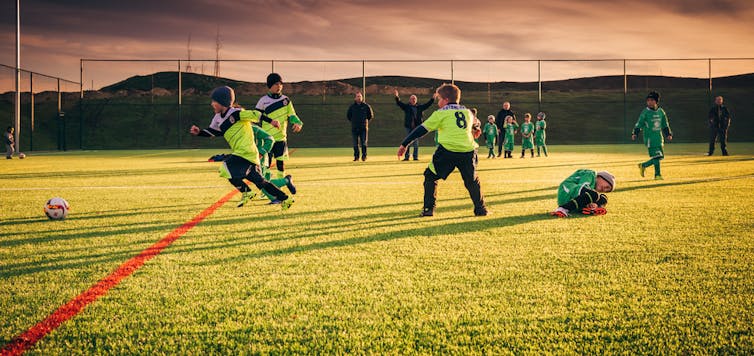Conversation A&E injuries
Comment: Children and sport injury-related A&E attendances
Published on: 2 November 2018
Writing for The Conversation, Professor Allyson Pollock and Graham Kirkwood discuss the study which found children under the age of 19 account for almost half of sport injury-related A&E attendances.

Encouraging children to play sport is a key part of the UK government’s childhood obesity strategy. The argument goes that children who play sport are physically active and therefore less likely to be obese. The problem with this argument is that the proponents conflate the undoubted benefits of physical activity, for which there is a great deal of evidence, with playing sport, for which there is no clear evidence that it helps reduce obesity.
While the benefits of sport are often overemphasised, the risk of injury is usually ignored. Yet studies from the US show that sports injuries are a major reason for children attending emergency departments and that sports injuries account for one-third of life-threatening injuries. Attendances resulting from concussion due to sports injuries have tripled over eight years.
For decades, the UK government has failed to collect injury data in a systematic way – and so most of the data on sport comes from ad hoc surveys, which are often dismissed by critics as incomplete. The government has now partly remedied this deficit by introducing the NHS Emergency Care Data Set (ECDS), which will collect data from all hospitals in England. The ECDS has the potential to provide data on all sports-related injuries needing emergency treatment in England.
In 2012, we were invited to analyse injury data from the pilot site of two NHS hospitals that were testing the feasibility of collecting injury data: the John Radcliffe in Oxford and Horton General Hospital in Banbury. We analysed all data collected on people attending the emergency departments for injuries between January 1, 2012 and March 30, 2014 and all hospital admissions for injuries.
Worrying results
Our analysis of the data revealed that of the nearly 64,000 people attending the emergency departments with an injury during this period, sports injuries accounted for almost one in five attendances, across all ages. Children and young adults (up to 19 years of age) accounted for almost half of all sports-injury emergency attendances and one-quarter of all inpatient admissions for serious trauma related to sport. Fourteen-year-old boys and 12-year-old girls were most at risk of sustaining a sports injury. These figures are similar to those in the US and Australia.
For boys, five sports accounted for two-thirds of sports injuries, the top three being football, rugby union and rugby league. For girls, five sports accounted for almost half of all injuries, the top three being trampolining (in the younger age groups), then netball and horse riding.
Almost one-quarter of all attendances for sports injuries were due to fractures, the highest proportion being for broken arms and collar bones. Rugby union was the sport most associated with head injury and concussion in boys. For girls, head injuries were most common during horse riding. Collision sports such as rugby and rugby league, which are played far less frequently than football and other non-collision sports, dominate A&E attendances for sports injuries.
All schools have a duty to keep children from harm. Sports England safeguarding strategy has largely focused on sexual abuse, but it should focus as much attention on the physical and mental risks of abuse and harms from sports injury, and it should work with schools and clubs to target sports-injury prevention at children in the first four years of secondary school.

For younger age groups, trampolines in the home need to be made safer. For older boys, schools should investigate mechanisms and causes of injury for football, and ban tackling in rugby as this is the phase of play when most injuries occur. For girls, we need to investigate ways to make netball, horse riding and trampolining safer.
If we extrapolate our figures to the whole of England, it’s equivalent to 68 boys and 34 girls in every thousand attending NHS emergency departments in a year due to sports-related injury. This is a heavy burden on the NHS and on children and families and carers and schools. An injured child is an inactive child – and time lost from school and harm to mental well-being as a result of injury also need to be considered. Children need to be physically active, but making organised sports as safe as possible must be part of any effective child obesity strategy.![]()
Allyson Pollock, Professor of Public Health, Newcastle University and Graham Kirkwood, Senior Research Associate, Newcastle University
This article is republished from The Conversation under a Creative Commons license. Read the original article.



